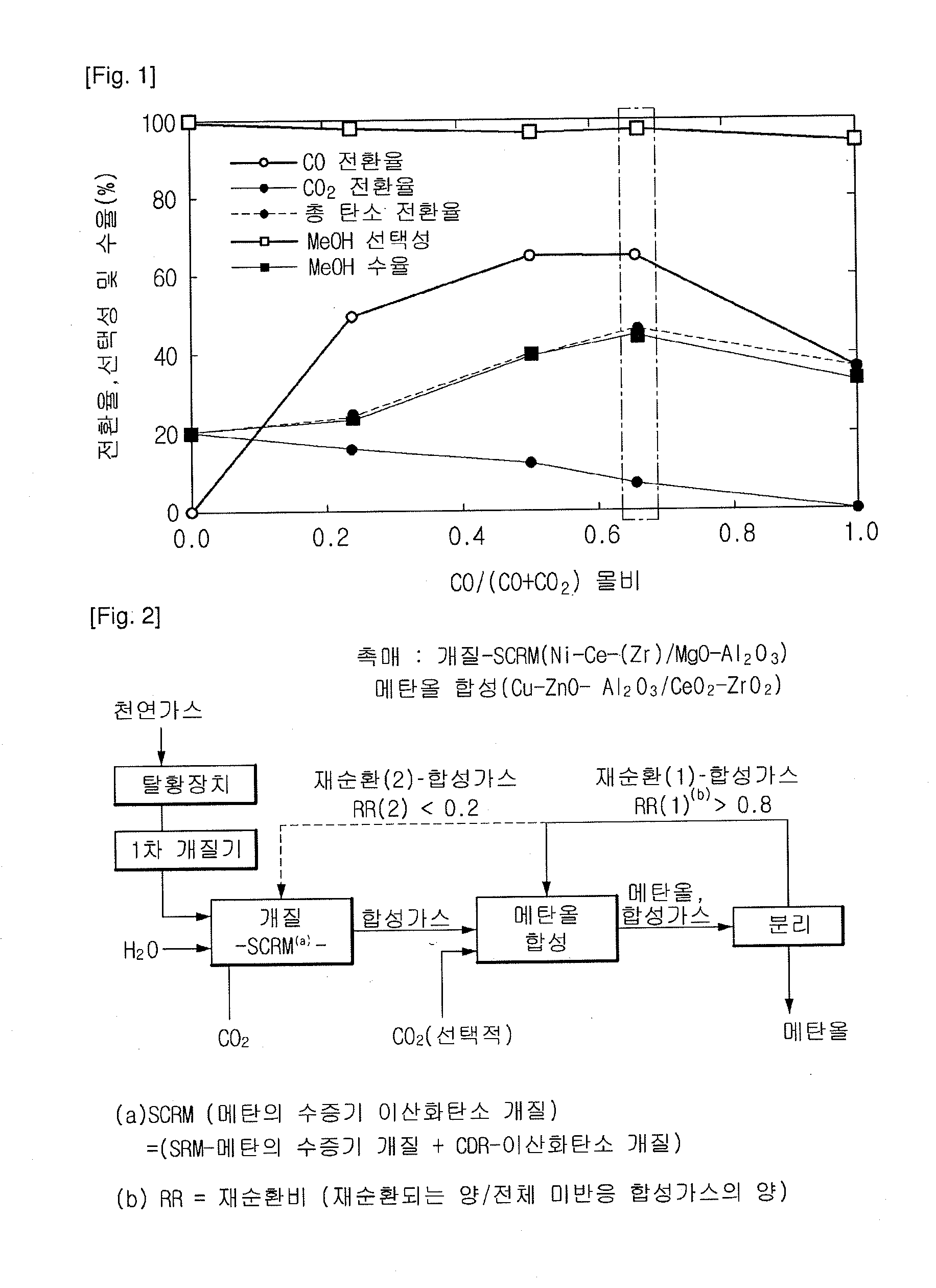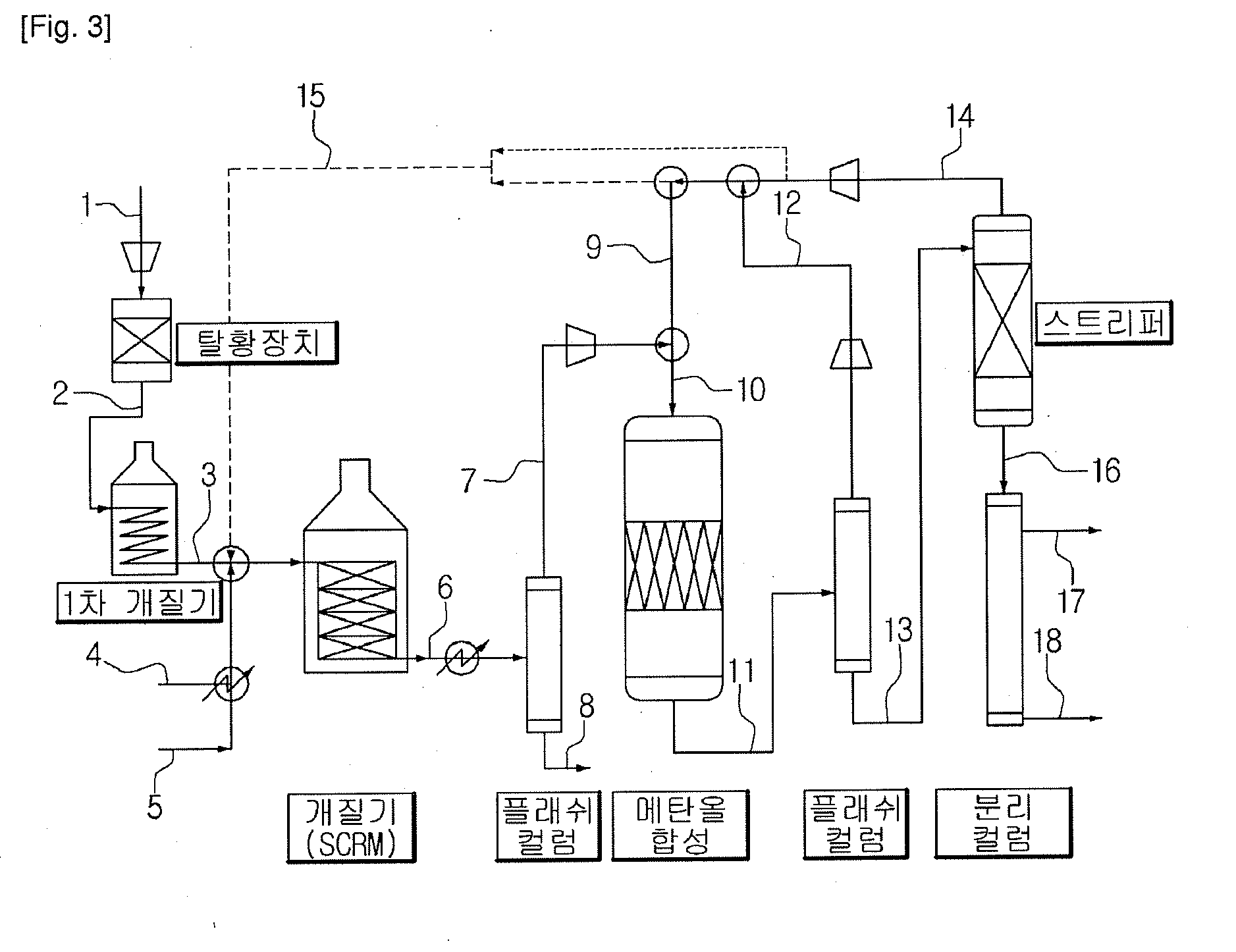Method for methanol synthesis using synthesis gas generated by combined reforming of natural gas with carbon dioxide
a technology of natural gas and synthesis gas, which is applied in the field of methanol synthesis using synthesis gas obtained from combined reforming of natural gas with carbon dioxide, can solve the problems of large-scale air separation unit, more severe deactivation of catalysts due to carbon deposition, and large-scale deactivation of catalysts, so as to reduce carbon dioxide emission and maximize carbon availability
- Summary
- Abstract
- Description
- Claims
- Application Information
AI Technical Summary
Benefits of technology
Problems solved by technology
Method used
Image
Examples
example 1
[0042]A catalyst for combined reforming is prepared according to our previous study (Korean Patent Application No. 2008-0075787).
[0043]First, PURAL MG30 (available from Sasol, specific surface area: at least 250 m2 / g), which is MgAlOx(30) with a hydrotalcite structure having an MgO / Al2O3 ratio of 3 / 7, is provided as a catalyst carrier for combined reforming. Next, the MgAlOx(30) carrier is impregnated with cerium acetate and zirconium acetate in such a manner that Zr / Ce ratio is 0.25 on the weight basis and Ce—Zr is carried on the MgAlOx (30) carrier at a ratio of 18 wt % based on the total weight of the carrier. At the same time, nickel nitrate hexahydrate (Ni(NO3)2.6H2O) as a nickel precursor is supported on the Ce—Zr / MgAlOx(30) carrier at a weight ratio of 15 wt % based on the total weight of the carrier. Then, the resultant product is agitated in a vacuum drier at 70° C. reactor, and is reduced under hydrogen atmosphere (10 vol % H2 / N2) at 750° C. for 5 hours, and a combined ref...
example 2
[0050]The integrated process is carried out by using the same catalysts as Example 1, except that the combined reforming is performed under a reaction pressure of 0.65 MPa with a space velocity of 1700 L / kg cat / h by feeding the reactants at a fixed molar ratio of CH4:CO2:H2O of 1:0.39:1.5 to the reforming reactor. In addition, the same catalyst for methanol synthesis as Example 1 is charged to the reactor in an amount of 350 g and the reaction for methanol synthesis is carried out under a reaction pressure of 5.0 MPa with a space velocity of 4700 L / kg cat / h by using the synthesis gas obtained from the combined reforming. Herein, the combined reforming reactor shows a temperature distribution of 755 to 990° C. and the catalyst bed of the reactor for methanol synthesis shows a temperature distribution of 223 to 295° C.
[0051]The catalysts for combined reforming and methanol synthesis are used to carry out an integrated process for preparing methanol from carbon dioxide. The recycle rat...
example 3
[0052]The integrated process is carried out by using the same catalysts as Example 1, except that the combined reforming is performed under a reaction pressure of 0.55 MPa with a space velocity of 1700 L / kg cat / h by feeding the reactants at a fixed molar ratio of CH4:CO2:H2O of 1:0.34:1.5 to the reforming reactor. In addition, the same catalyst for methanol synthesis as Example 1 is charged to the reactor in an amount of 350 g and the reaction for methanol synthesis is carried out under a reaction pressure of 5.0 MPa with a space velocity of 4300 L / kg cat / h by using the synthesis gas obtained from the combined reforming. Herein, the combined reforming reactor shows a temperature distribution of 755 to 995° C. and the catalyst bed of the reactor for methanol synthesis shows a temperature distribution of 216 to 298° C.
[0053]The catalysts for combined reforming and methanol synthesis are used to carry out an integrated process for preparing methanol from carbon dioxide. The recycle rat...
PUM
| Property | Measurement | Unit |
|---|---|---|
| Temperature | aaaaa | aaaaa |
| Temperature | aaaaa | aaaaa |
| Fraction | aaaaa | aaaaa |
Abstract
Description
Claims
Application Information
 Login to View More
Login to View More - R&D
- Intellectual Property
- Life Sciences
- Materials
- Tech Scout
- Unparalleled Data Quality
- Higher Quality Content
- 60% Fewer Hallucinations
Browse by: Latest US Patents, China's latest patents, Technical Efficacy Thesaurus, Application Domain, Technology Topic, Popular Technical Reports.
© 2025 PatSnap. All rights reserved.Legal|Privacy policy|Modern Slavery Act Transparency Statement|Sitemap|About US| Contact US: help@patsnap.com



